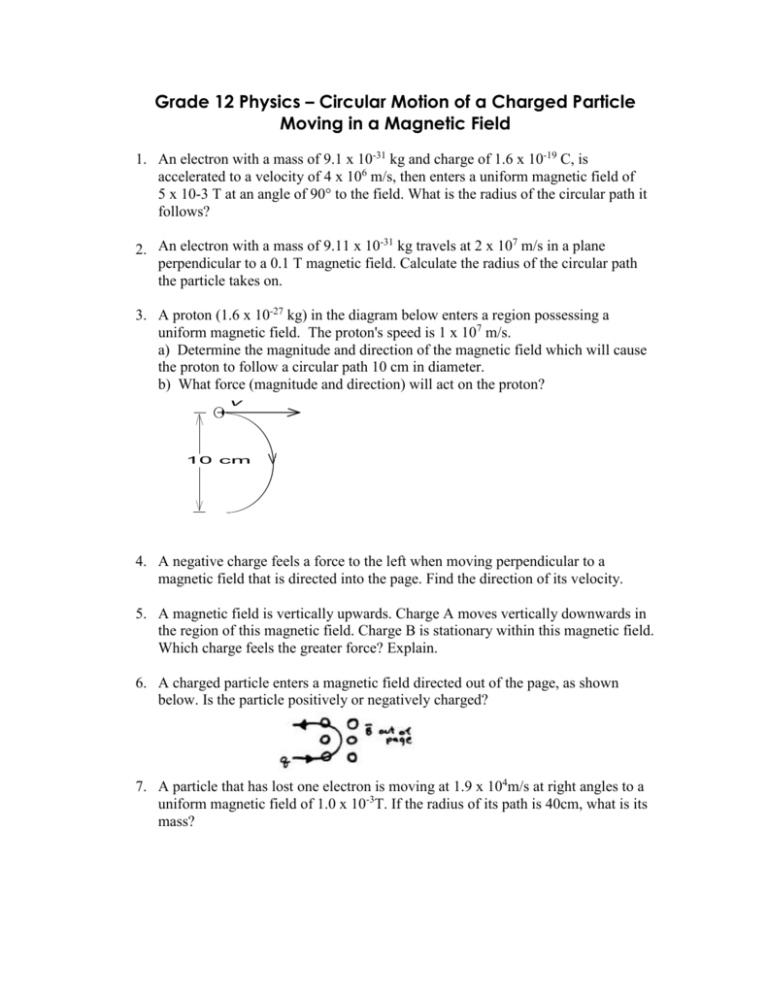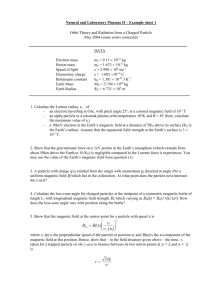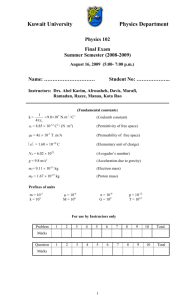Circular Motion of a Charged Particle Moving in a Magnetic Field
advertisement

Grade 12 Physics – Circular Motion of a Charged Particle Moving in a Magnetic Field 1. An electron with a mass of 9.1 x 10-31 kg and charge of 1.6 x 10-19 C, is accelerated to a velocity of 4 x 106 m/s, then enters a uniform magnetic field of 5 x 10-3 T at an angle of 90° to the field. What is the radius of the circular path it follows? -31 7 2. An electron with a mass of 9.11 x 10 kg travels at 2 x 10 m/s in a plane perpendicular to a 0.1 T magnetic field. Calculate the radius of the circular path the particle takes on. 3. A proton (1.6 x 10-27 kg) in the diagram below enters a region possessing a uniform magnetic field. The proton's speed is 1 x 107 m/s. a) Determine the magnitude and direction of the magnetic field which will cause the proton to follow a circular path 10 cm in diameter. b) What force (magnitude and direction) will act on the proton? v + c B 10 cm e x d 4. A negative charge feels a force to the left when moving perpendicular to a magnetic field that is directed into the page. Find the direction of its velocity. 5. A magnetic field is vertically upwards. Charge A moves vertically downwards in the region of this magnetic field. Charge B is stationary within this magnetic field. Which charge feels the greater force? Explain. 6. A charged particle enters a magnetic field directed out of the page, as shown below. Is the particle positively or negatively charged? 7. A particle that has lost one electron is moving at 1.9 x 104m/s at right angles to a uniform magnetic field of 1.0 x 10-3T. If the radius of its path is 40cm, what is its mass? 8. A particle with a charge of +1.0ec and a mass of 3.9 x 10-25kg is accelerated from rest through a potential difference of 1.0 x 105V while passing through parallel plates. It then exits the parallel plates and enters a magnetic field of 0.1T that is perpendicular to its motion. Find the radius of the path it would follow in the magnetic field. (Hint: before you can find the radius, you need its velocity when it exits the plates) 9. An ion with a charge of +2.0ec moves through a magnetic field of 2.0T along a path with a radius of 5.0cm. If the magnetic field is at a right angle with its path, find the momentum of the ion. 10. Consider the diagram below. If charge q enters the magnetic field with a kinetic energy of 4.0J and a radius of path of 0.5m, what is the force acting on the charge? Answers: 1. 4.6 x 10-3 m 2. 1.1 mm 3. (a) B = 2.0 T [up] (b) 3.2 x 10 – 12 N [South] 4. South 5. Both feel no force. Charge A has no velocity and Charge B is moving parallel to the magnetic field. 6. Negative 7. 3.4 x 10-27kg 8. 7.0m 9. 3.2 x 10-20 kgm/s 10. 16 N This one is tricky. KE = ½mv2 = ½ mvv, so mv=2KE/v and we know mv=qBR, so 2KE/v=qBR, which re-arranges to 2KE/R=qvB but, we want force and F=qvB, so using the above, F=2KE/R 1.a) r = mv / qB so, B = mv / qr = (1.6 x 10 – 27 kg) (1 x 107 m/s) / (1.6 x 10 – 19 C)(0.10 m) B = 1.04 T This field must be pointing out of the page. b) F = q v B = (1.6 x 10 – 19 C)(1 x 107 m/s)(1.04 T) = 1.66 x 10 – 12 N downward.









